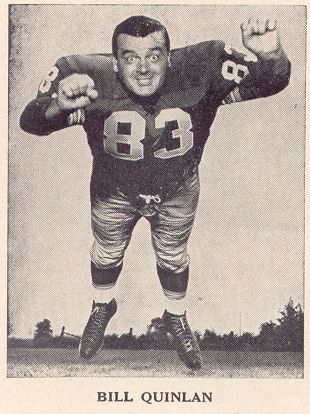Huck ‘n’ Buck
Jim Laughead and Brad Bradley toured America as the most accomplished football photographers of their era. Laughead perfected the art of  getting posed “action” shots of football players. Sounding like an oxymoron, posed “action” is what you see on the vast majority of the Post cereal cards.
getting posed “action” shots of football players. Sounding like an oxymoron, posed “action” is what you see on the vast majority of the Post cereal cards.
On team picture day, Laughead Photographers would set up a shooting area that consisted of two flags stuck in the ground about ten feet apart with a chalk line connecting the flags. A slate with the players’ name would be propped against one of the flags. In this setting, Jim Laughead began his photographic magic by demonstrating exactly how he wanted the player to move while approaching the opening between the two flags. Setting the camera at a low angle, most often on the ground, he would trip the shutter just as the player was at the desired point in the shooting area. Laughead's demonstrations, cajoling and timing set his photographs apart. The players’ facial expressions are the signature of a Jim Laughead photograph.
Many times Laughead would talk a player into doing the "Death Dive" which consisted of what amounted to a belly buster sans the water. The look on the player's face, knowing he was just about to slam face first into the ground was a cross between terror and wonder. The results were unmatchable. Just ask Packers defensive end Bill Quinlan what it was like in 1960.
Most often, Laughead would merely demonstrate the “Huck ‘n’ Buck” that resulted in what Edwin “Bud” Shrake in his 1964 article “The Mad Hatter in Photoland” referred to as “photographic cliché—of the leaping stiff-arm, the I-despise-you scowl, the halfback crossover that looks like a ballet step...” The story also explains that the term “Huck ‘n’ Buck” was an offshoot of a dance step known to college football players of that era as the Huckle-Buck. The reader is highly encouraged to check out this extremely entertaining piece about Laughead Photographers.

